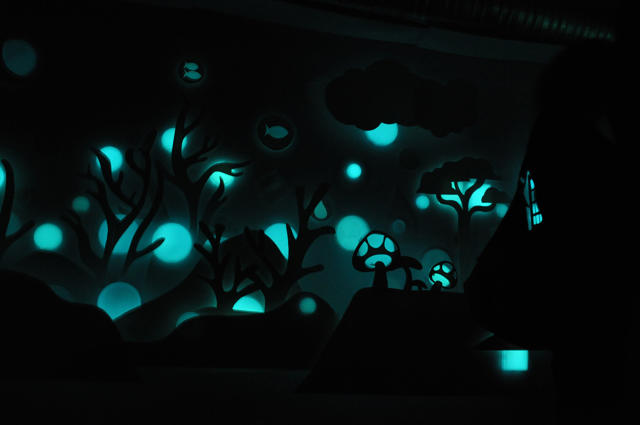In France, light pollution laws prevent retailers from illuminating their shop windows between 1 a.m. and 7 a.m. But one day, Sandra Rey dreams that if you went for a midnight stroll down the Champs-Élysées, the shop windows and signs would glow an otherworldly glow, from a source of illumination usually only seen darting through the dark waters of the ocean at night.
To make that happen, Rey's company, Glowee, just launched its first commercial product: a bacteria-powered light that the company is marketing to retailers through France. It works by trapping a bacterium called Aliivibrio fischeri, which gives sea creatures like the Hawaiian bobtail squid their bluish bioluminescent glow, inside a transparent pack of nutrient gel. As the bacterium eats, it gives off a blue-green glow, with about the intensity of a nightlight. That doesn't sound like much, but "the great thing is that even if the intensity is lower, the fact that [the light is all] surface [area] provides bigger illumination zones," Rey explains over email.

Even so, that's not enough raw lighting power to replace traditional bulbs or LEDs. But they don't have to be. In addition to retail windows at light, she envisions Glowee being used for decorative lighting, city signage, floor lighting, safety lighting, at festivals, and so on. And there are other advantages: Glowee doesn't require electrical infrastructure. The cases that hold the Glowee gel are made of fully customizable organic resin, which is about 1 centimeter thick; while they are almost envelope-like in appearance now, they could be custom-molded into any shape by artists and designers who want to create their own Glowee-powered designs.
There are challenges ahead, though. For one, replacing light bulbs with what are, in essence, bacteria-filled food bags is its own unique problem—especially with regards to how long they last. Right now, a Glowee will only emit light for three days before going dark. At that point, Glowee will come by and replace it; the fledgling company operates on a subscription-model, in which retailers essentially rent their lights. Considering that many LEDs can emit two years worth of light or more, three days seems miniscule. But it's orders of magnitude better than Glowee's initial prototypes, which only emitted light for a few seconds. In fact, by tweaking their nutrient gel, Glowee thinks that by 2017, its lights will easily last a month. And because Glowee's business is subscription-based, customers who rent a light now will see it slowly improve over time with more development.

In the longer term, Glowee is hard at work genetically engineering its bacteria to only activate their bioluminescence at night—as well as reproduce at a slower rate. That could get a Glowee lamp's lifespan up to a year or more. And Rey says the possibility of improving Glowee's intensity through genetic engineering is also "huge." For now, though, Glowee is best used for temporary signage, which is why its earliest customers—while still confidential—are in industries like retail and construction, for safety and warning lights.
But with backing from companies like ERDF, which manages 95% of France's electrical grid, Rey says she ultimately hopes that Glowee lights will make a significant impact on the world's electricity usage—around 19% of which goes to the production of light. If she's successful, nighttime in cities may take on a distinctly cyberpunk glow.
All Images: via Glowee